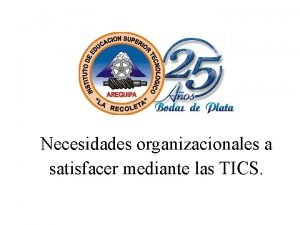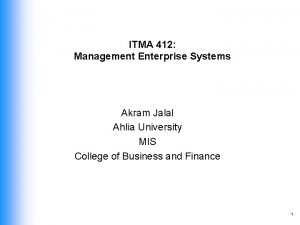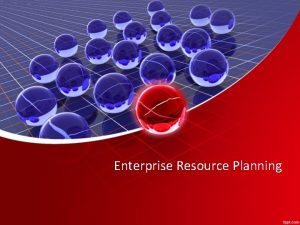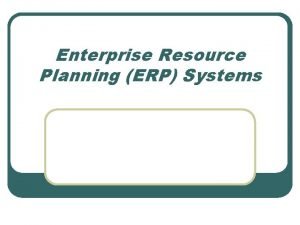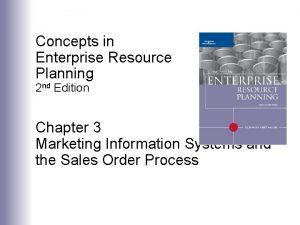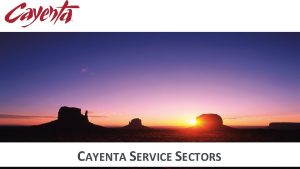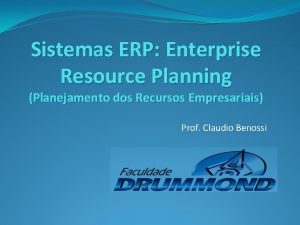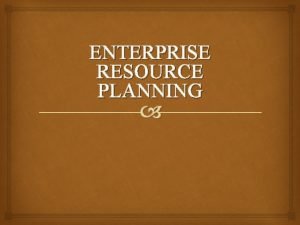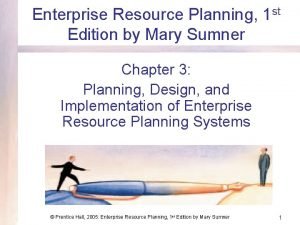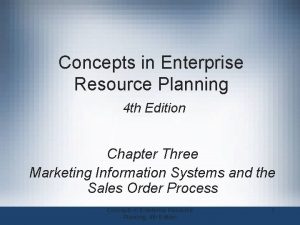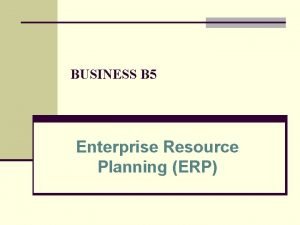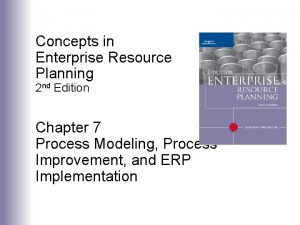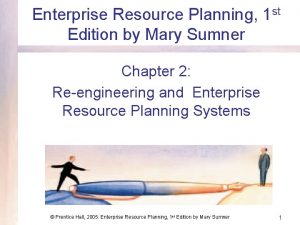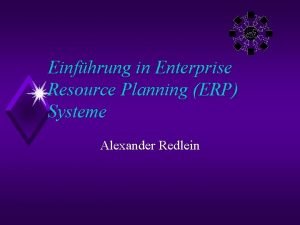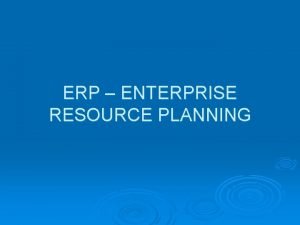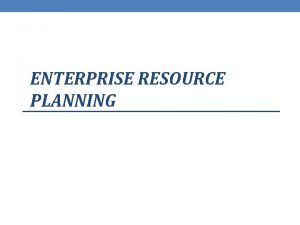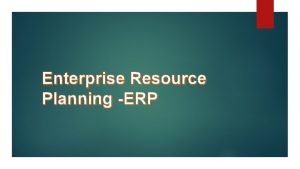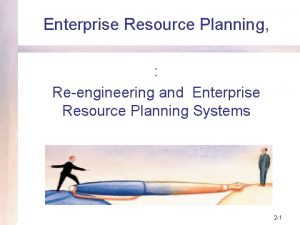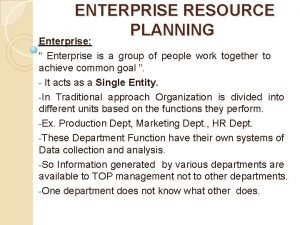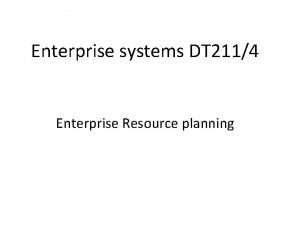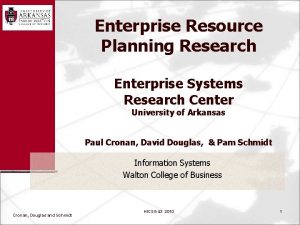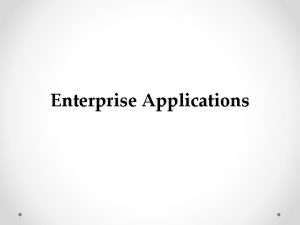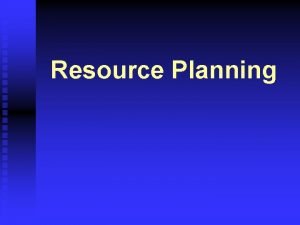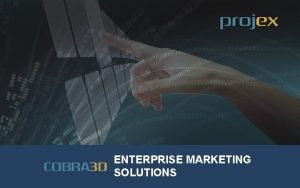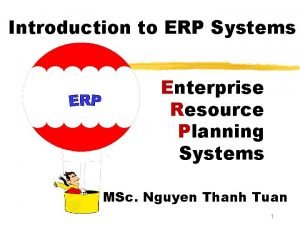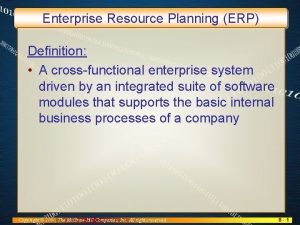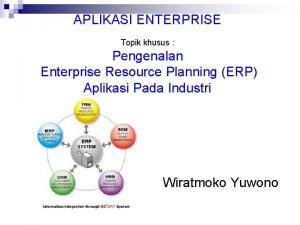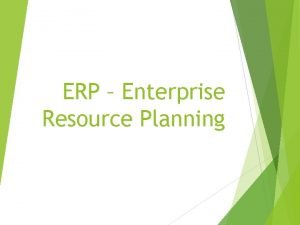Enterprise Resource Planning Systems ERPs Rule Copyright 2016

















- Slides: 17

Enterprise Resource Planning Systems ERPs Rule! Copyright © 2016 Curt Hill

Introduction • We previously saw the evolution of business data processing • Starts out with standalone programs that perform a single function – Often built by the enterprise • Develops into a suite of programs that communicate with each other – Often built by a software vendor • Arrives at an ERP – Highly configurable program using a database as its storage facility Copyright © 2016 Curt Hill

What is an ERP? • Business management software that integrates applications to manage the business • The practice of consolidating an enterprise’s planning, manufacturing, sales and marketing efforts into one management system • ERP automates the tasks involved in performing a business process Copyright © 2016 Curt Hill

Diagram Managers and Stakeholders Sales and Delivery Human Applications Customers Resource Management Sales. Applications Force And Customer Service Reps Service Applications Financial Reporting Applications Central Database Manufacturing Applications Back-office Human Resource Management Applications Employees Copyright © 2016 Curt Hill Inventory And Supply Applications Suppliers

• Finance Components – General ledger – Accounts receivable and payable • Human Resources – Payroll – Administration • Manufacturing – Production planning – Materials management • There may be many others depending on particular ERP system Copyright © 2016 Curt Hill

Picture Copyright © 2016 Curt Hill

Characteristics • Most ERPs are highly modular and highly configurable • Modular – Enterprise purchases the modules that are needed and not others • Configurable – Much easier to tailor to the enterprise than most previous software suites – The configuration does not alter the programming code of the system • All tasks are to reflect best practices Copyright © 2016 Curt Hill

ERP and Externals • The ERP will usually interface with the value chain • It may process orders from customers • It may initiate orders to suppliers • Both of these are subject to configuration for this company Copyright © 2016 Curt Hill

Implementation • Major project: may take 1 – 3 years – The important thing is not to focus on how long it will take but to understand why you need ERP and how you will use it to improve your business • Short implementations (3 to 6 months): – small companies – implementation limited to a small area of the company – the company only used the certain pieces of the ERP system Copyright © 2016 Curt Hill

Costs and Benefits • One study among 63 companies surveyed showed that the average Total Cost Ownership was $15 million – The highest was $300 million and lowest was $400 k • It also found that: – Took 8 months after the system was in to see any benefits – Median annual savings was $1. 6 million per year Copyright © 2016 Curt Hill

Hidden Costs • • • Training Integration and testing Data conversion Data analysis Consultants Waiting for gains to appear Copyright © 2016 Curt Hill

Benefits of ERP Systems • • • Improving integration, flexibility Fewer errors Improved speed and efficiency More complete access to information Lower total costs in the complete supply chain • Shorten throughput times • Sustained involvement and commitment of the top management

Benefits Continued • • Reduce stock to a minimum Enlarge product assortment Improve product quality Provide more reliable delivery dates and higher service to the customer • Efficiently coordinate global demand, supply and production

Risks of Implementation • • • Expense Time-consuming Great risk for the organization Transfer of Knowledge Acceptance with the company

ERP Implementation • Biggest IT project that most companies ever handle • Changes the entire company • Has repercussions in all departments and divisions of the organization • It is essential that all the key players understand the scope of the project • This is an IT-Related Project

• SAP The Big Players • Many of the worlds largest companies use SAP software • 24% of the ERP market in 2012 • Oracle • Best known for database software • ERP acquisitions: JD Edwards, People. Soft, Siebel CRM • 13% of the ERP market in 2012 • Microsoft • Gained ERP software through acquisition of Great Plains • 5% of the ERP market in 2012 Copyright © 2016 Curt Hill

Conclusion • ERPs are the big ticket of enterprise software – Very expensive – Very often worth it • They integrate most of the well-known business processes in one application – Eliminates redundant and inconsistent data – Eases data transfers Copyright © 2016 Curt Hill
 Heinsohn nomina erps
Heinsohn nomina erps Enterprise resource planning example
Enterprise resource planning example Enterprise resource planning overview
Enterprise resource planning overview Enterprise resourse planning systems
Enterprise resourse planning systems Enterprise resource planning concepts
Enterprise resource planning concepts Cayenta payroll management
Cayenta payroll management Enterprise resource planning tradução
Enterprise resource planning tradução Contoh enterprise resource planning
Contoh enterprise resource planning Enterprise resource planning mary sumner
Enterprise resource planning mary sumner Concepts in enterprise resource planning
Concepts in enterprise resource planning Core erp components
Core erp components Contemporary management ppt
Contemporary management ppt Fitter snacker
Fitter snacker Enterprise resource planning mary sumner
Enterprise resource planning mary sumner Sistem enterprise resource planning
Sistem enterprise resource planning Resource loading vs resource leveling
Resource loading vs resource leveling Perbedaan resource loading dan resource leveling
Perbedaan resource loading dan resource leveling Enterprise resource definition
Enterprise resource definition
